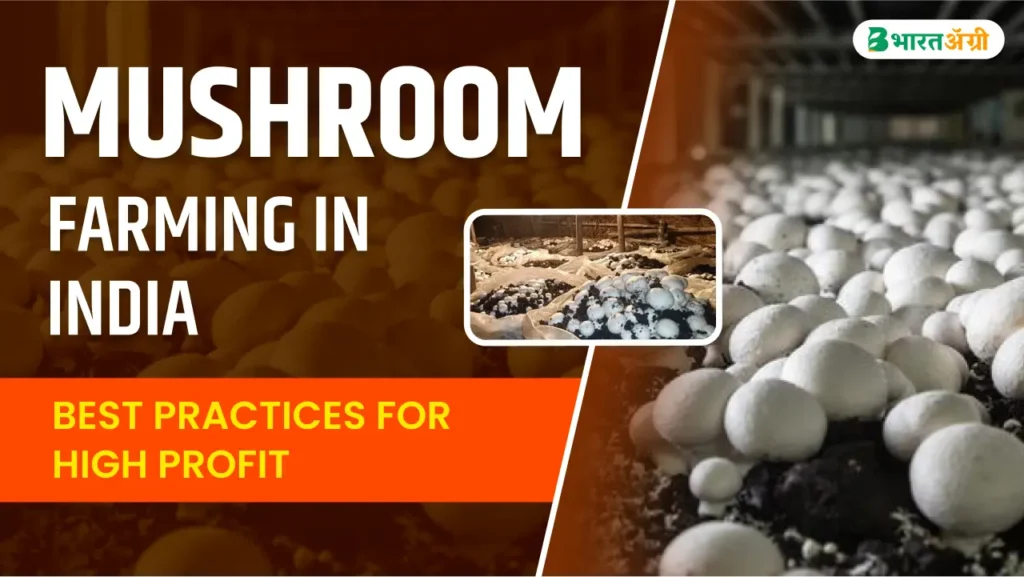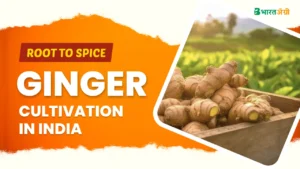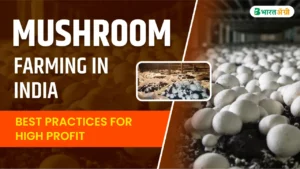
In today’s changing world, mushroom farming has become a profitable business. In this blog, we will discuss in detail the modern methods of mushroom farming, including how to start a mushroom business. Learn how to grow high-quality mushrooms using the right techniques, climate control, nutritional materials, and advanced equipment. Whether you are a new farmer or an experienced one, this article will prove to be valuable for you.
Mushroom Farming in India
Mushroom farming has emerged as one of the most profitable farming practices in India, and it is rapidly growing into a highly rewarding industry. Today, mushroom farming stands out as one of India’s most fruitful agricultural pursuits. It is gaining popularity due to its ability to transform laborious farming efforts into substantial profit. Farmers across India are increasingly recognizing the potential of mushroom cultivation to supplement their primary income, making it an appealing option for both small and large-scale growers. States like Uttar Pradesh, Kerala, and Tripura have become key regions for commercial mushroom production due to favorable climatic conditions. With the growing demand for organic and healthy food, mushroom farming provides excellent opportunities for farmers to explore both domestic and export markets. Understanding the mushroom growing process is crucial for maximizing yield and profitability, further enhancing the attractiveness of this burgeoning industry.
Types of Mushroom in India
There are three types of mushrooms that are primarily grown in India, as mentioned below.
Button Mushroom (Agaricus bisporus)
Button mushrooms are one of the most widely consumed varieties in India. These edible fungi, which are actually the younger form of Agaricus bisporus, also include cremini and portobello mushrooms. Characterized by their smooth, white caps measuring between 1 to 3 inches, button mushrooms are known for their mild flavor and versatility in Indian and global cuisines.
Straw Mushroom (Volvariella volvacea)
Commonly referred to as paddy straw mushrooms, these mushrooms are widely cultivated across East and Southeast Asia and are gaining popularity in India as well. Known for their unique flavor, straw mushrooms are widely used in a variety of dishes, especially in Asian cuisines. While fresh straw mushrooms are available in some regions, they are often sold in canned or dried forms across India.
Oyster Mushroom (Pleurotus ostreatus)
Oyster mushrooms are one of the most popular cultivated mushrooms, particularly favored for their broad, fan-shaped caps and delicate texture. They come in shades of white, gray, and tan and are rich in nutrients. Widely grown in India, oyster mushrooms are valued for their taste and ease of cultivation, making them a favorite among Indian mushroom farmers.
Preparation and Cultivation of Mushrooms
Preparation and cultivation of mushrooms involve creating nutrient-rich compost, followed by spawning mycelium and providing the ideal moisture and temperature conditions for growth. With proper casing and careful harvesting techniques, mushrooms thrive, leading to a profitable yield. Below are the 3 types of mushroom cultivation and their growing processes.
Button mushrooms
Button mushrooms, also known as white mushrooms, baby mushrooms, or cultivated mushrooms, are among the most popular types of mushrooms in India. They are widely consumed in various forms raw in salads, cooked in soups, or used as toppings for pizzas. Introduced in the sixteenth century, button mushrooms now account for about 85% of India’s annual mushroom production, making them a staple in the mushroom farming industry.
Process of Button Mushroom Cultivation:
- Composting
The first step in cultivating button mushrooms is compost preparation. This process occurs on clean concrete platforms where the mushrooms are grown. There are two main types of compost used:- Natural Compost: This is made from natural materials such as wheat straw, horse manure, chicken manure, and gypsum. These ingredients are spread evenly on the composting area and then moistened using a water sprayer.
- Synthetic Compost: Synthetic compost is created by mixing urea, gypsum, wheat straw, bran, and either ammonium nitrate or ammonium sulfate. The straw is chopped into 8-20 cm pieces, moistened, and mixed with the other ingredients.
- Filling Compost Trays
Once the compost is ready, it should be a deep brown color. The compost should neither be too wet nor too dry when placed in the trays. The tray depth should be around 15-18 cm, and it is important that they are made of softwood. The compost is evenly spread to the brim of the trays. - Spawning
Spawning is the process of introducing mushroom mycelium into the prepared compost. This can be done by either spreading the mycelium over the compost or mixing it directly into the compost. After spawning, the trays are lightly sprayed with water and covered with newspapers to retain moisture. - Casing
Casing involves covering the compost in the trays with a layer of casing soil. This soil is typically a mixture of garden soil and decomposed cow manure, which helps retain moisture and promotes mushroom growth. - Harvesting
Harvesting button mushrooms requires careful handling. To harvest, gently grip the mushroom cap, press it into the soil, and twist it off. The base of the stalk, which may have dirt and mycelial threads, should be cut off before the mushroom is used or sold.
Paddy Straw Mushrooms
Paddy straw mushrooms, scientifically known as Volvariella volvacea, are a highly sought-after variety of edible mushrooms in India. Here’s a detailed guide on mushroom cultivation steps.
Process of Paddy Straw Mushroom Cultivation:
1. Spawning
The first step in cultivating paddy straw mushrooms is spawn preparation. Farmers either acquire a starter culture from a certified agency or create their own using tissue culture, single spore, or multispore techniques. Since paddy straw mushroom cultures cannot be preserved at low temperatures, they are usually stored at a temperature between 17°C to 20°C or above.
The spawn is cultivated on substrates such as paddy grains or straw. After inoculating the substrate, it is incubated at 30-35°C for about 5-7 days, during which the mycelium colonizes the substrate completely. It is essential to use the spawn within 10-15 days, as it cannot be stored for long periods.
2. Bed Preparation
Here’s a step by step process for bed preparation:
- Straw Selection: Select clean, dry paddy straw free from mold and contaminants. Wheat or barley straw may also be used.
- Cutting Straw: The straw is cut into 3-5 cm pieces using a sickle or chaff cutter. This increases the surface area for mycelium colonization.
- Soaking Straw: The cut straw is soaked in clean water for 12-16 hours to enhance moisture content.
- Boiling Straw: After soaking, the straw is boiled for 1-2 hours to eliminate harmful microorganisms.
- Cooling and Draining: The boiled straw is spread out to cool and drain excess water, ensuring no waterlogging occurs.
- Mixing Spawn: Mushroom spawn is thoroughly mixed with the cooled straw to ensure even colonization.
- Forming Mushroom Beds: The spawned straw is packed into beds or bags. The beds are covered with newspaper or plastic to maintain humidity.
3. Harvesting
Paddy straw mushrooms are harvested when young, typically within 2-3 days after pinheads appear. Careful plucking ensures that the mycelium is not disturbed, allowing for successive harvests. Mushrooms are best harvested early in the morning or late in the evening to avoid wilting. They can either be consumed fresh or preserved for future use.
Oyster Mushroom Farming
Oyster mushroom farming is gaining popularity in India due to its profitability and ease of cultivation. Here’s a detailed step-by-step guide for Indian farmers interested in growing oyster mushrooms:
1. Spawn Production
The first step is producing spawn, which is the seed material for mushrooms. Sterilize a mixture of wheat or sorghum grains, then inoculate it with mushroom mycelium. Keep the inoculated grains in an incubator at 25°C for 15-20 days until the mycelium has fully colonized the grains.
2. Substrate Preparation
Oyster mushrooms thrive on various substrates such as straw, sawdust, or agricultural waste. Cut the substrate into small pieces, soak it in water for 12-24 hours, and then sterilize it by boiling at 100°C for 1-2 hours to eliminate any contaminants.
3. Inoculation
Once the substrate is cooled to room temperature, inoculate it with the prepared spawn. Mix the spawn evenly into the substrate to ensure proper colonization. Place this mixture into polythene bags or bottles and seal them to avoid contamination.
4. Incubation
Keep the inoculated bags or bottles in a dark, humid environment to allow the mycelium to colonize the substrate. Incubation typically takes 15-20 days at a temperature of 25-30°C. Maintain a sterile environment to ensure healthy growth.
5. Fruiting
Once the substrate is fully colonized, expose it to light and fresh air to trigger fruiting. Reduce the temperature to 15-20°C and maintain humidity at 85-90%. Within 5-7 days, mushrooms will start to appear.
6. Harvesting
Oyster mushrooms are ready to harvest when the caps’ edges begin to turn upwards. This usually occurs 5-7 days after the mushrooms first emerge. Gently pluck the entire mushroom and trim the base.
7. Post-Harvest Handling
After harvesting, clean and sort the mushrooms by size and quality. To preserve them, dry the mushrooms at 50-60°C until their moisture content reduces to 10-15%. This helps in extending their shelf life and maintaining quality.
With proper care and management, farmers can achieve a yield of 20-25 kg of fresh ushrooms from 100 kg of dry substrate. Factors like the strain, substrate quality, and environmental control significantly impact the yield. Cleanliness and strict hygiene are crucial throughout the process to ensure a successful crop.
Profitability in Mushroom
Mushroom farming can be highly profitable with the right approach. On average, 1 square meter of cultivation space can produce around 10-12 kg of mushrooms in a crop cycle. The current market rate for fresh mushrooms ranges between ₹150 to ₹250 per kg, depending on the variety and region. With a standard setup, farmers can produce about 6,000 to 10,000 kg annually. This translates to potential earnings of ₹9 to ₹25 lakhs per year, based on market conditions. With low initial investment and high demand, mushroom farming offers excellent profit margins for small and large-scale farmers alike.
Conclusion
- Mushroom Farming Growth: Mushroom farming in India is a rapidly growing and profitable industry, with increasing recognition among farmers as a viable source of income.
- Types of Mushrooms: Key types cultivated in India include Button Mushrooms, Straw Mushrooms, and Oyster Mushrooms, each with distinct characteristics and cultivation methods.
- Button Mushrooms: Popular and widely consumed, they require careful compost preparation, spawning, casing, and harvesting to ensure a high yield.
- Paddy Straw Mushrooms: Known for their unique flavor, they involve specific steps such as spawn preparation, bed formation, and proper harvesting techniques for optimal results.
- Oyster Mushrooms: Valued for their ease of cultivation and nutrient-rich profile, they need proper spawn production, substrate preparation, and environmental control for successful farming.
- Yield and Quality: With appropriate techniques and maintenance, farmers can achieve significant yields and quality, benefiting from mushroom farming’s profitability and growing market demand.
- Market Prices: The mushroom price per kg in India typically ranges from ₹200 to ₹400, depending on the type, quality, and market conditions. This can provide farmers with a lucrative return on their investment.
FAQs
Mushroom farming can yield substantial profits, with potential earnings reaching up to ₹1,90,000 annually. It’s a low-investment venture with minimal space requirements.
Button mushrooms and oyster mushrooms are considered the best for farming in India due to their high demand and ease of cultivation.
The price of 1 kg of mushroom seeds typically ranges from ₹300 to ₹600, depending on the type and quality.



